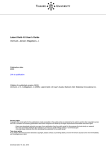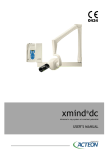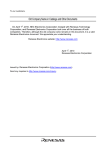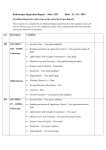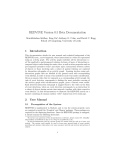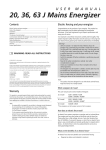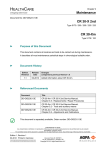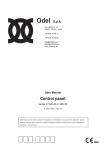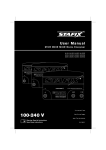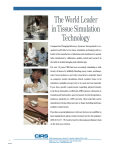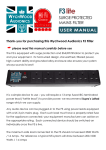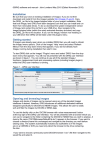Download BREAST DOSE SURVEYS IN THE NHSBSP: SOFTWARE AND
Transcript
BREAST DOSE SURVEYS IN THE NHSBSP: SOFTWARE AND INSTRUCTION MANUAL Version 2.0 Report 04/ July 2004 K C Young National Co-ordinating Centre for the Physics of Mammography Guildford Breast dose surveys in the NHSBSP: software and instruction manual V2.0 CONTENTS 1. INTRODUCTION................................................................................................................................ 2 2. DOSIMETRY PROTOCOL USED ................................................................................................... 2 3. NEW FEATURES IN THIS VERSION............................................................................................. 2 3.1 New standard breast.................................................................................................................. 2 3.2 Diagnostic reference level......................................................................................................... 3 3.3 Correcting for age....................................................................................................................... 3 3.4 Calculation of exposure times .................................................................................................. 3 3.5 Record of compression force.................................................................................................... 4 3.6 Change to s-factors.................................................................................................................... 4 4. SURVEY METHODOLOGY.............................................................................................................. 4 5. USING THE SOFTWARE TO CALCULATE DOSES IN A BREAST DOSE SURVEY ........... 4 6. 7. 5.1 Introduction.................................................................................................................................. 4 5.2 Mammography system details.................................................................................................. 5 5.3 X-ray set data.............................................................................................................................. 5 5.4 Exposure data............................................................................................................................. 7 5.5 Calculated MGD ......................................................................................................................... 9 5.6 Graph of data ............................................................................................................................ 10 5.7 Summary of analysis................................................................................................................ 10 5.8 Printed report ............................................................................................................................ 11 MAINTAINING THE DATABASE ................................................................................................... 11 6.1 Backing up data ........................................................................................................................ 11 6.2 Deleting dose surveys ............................................................................................................. 12 6.3 Incorporating survey data from previous version................................................................. 12 REFERENCES ................................................................................................................................. 12 APPENDIX 1: NHSBSP PATIENT DOSE DATA RECORDING FORM........................................ 13 APPENDIX 2: METHOD OF DOSE CALCULATION ....................................................................... 15 APPENDIX 3: TABLES AND FIELDS USED TO CALCULATE DOSE......................................... 16 APPENDIX 4: MODIFICATION OF DOSE CALCULATION TO ADJUST FOR AGE ................. 17 NHSBSP July 2004 1 Breast dose surveys in the NHSBSP: software and instruction manual V2.0 1. INTRODUCTION Measuring the mean glandular dose to the standard breast1 has for many years been the main means of assessing the doses from mammographic systems. Although this is a valuable and simple approach to dose measurement it provides limited information on the doses received by individual women. As a result the periodic measurement of doses for samples of women undergoing mammographic examinations is recommended.2,3 This manual describes the use of Version 2.0 of a software programme that calculates and stores the results of such dose surveys. (The latest version of the previously distributed software was known as Version 16 i.e. the 16th variation of Version 1.) It is intended that the use of this software will help to standardise dose measurements and simplify procedures for national reviews of radiation doses in the NHS Breast Screening Programme. The software incorporates the changes in the UK dosimetry protocol outlined by Dance et al.4 2. DOSIMETRY PROTOCOL USED The UK and European protocols for mammographic dosimetry use conversion factors that relate incident air kerma to the mean glandular dose (MGD) within the breast. The conversion factors published in IPSM 59/2 were obtained by computer simulation of a model breast with composition 50% adipose and 50% glandular tissues by weight (50% glandularity). Dance et al 4 have published additional conversion factors which allow the extension of the protocols to breasts of varying glandularity and for a wider range of mammographic x-ray spectra. The data have also been extended to breasts of compressed thickness 11 cm. To facilitate the calculation of MGD in patient surveys, typical breast glandularities are tabulated for women in the age ranges 40-49 and 50-64 and for breasts in the thickness range 2-11 cm. The software provided with this publication facilitates the implementation of a breast dose survey using these procedures using equation 1. D=Kgcs (1) where the factor g is unchanged from that given in IPSM 59/2 and corresponds to a glandularity of 50%. The factor c corrects for any difference in breast composition from 50% glandularity. cfactors have been calculated by Dance et al 4 for typical breast compositions at different compressed breast thicknesses in the age ranges 50 to 64 and 40 to 49. The factor s makes a correction for the use of an X-ray spectrum other than Mo/Mo. 3. NEW FEATURES IN THIS VERSION 3.1 New standard breast The Quality Assurance Standards for the NHSBSP were revised on 1st April 2004. In these the dose standard is based on the new standard breast model introduced in IPEM Report 89. The data published in Dance et al (2000) for the equivalence between Perspex and typical compressed breasts has been used to establish a new standard breast simulated with a 45mm thick Perspex phantom instead of the 40mm thick phantom used previously. The new standard breast model can be expected to result in doses that are approximately 25% greater than those found with the old model if the same beam quality (28 kV Mo/Mo) is used. However the exposures should be at the clinical settings. The minimum standard for the mean glandular dose for the new standard breast at clinical settings is less than or equal to 2.5 mGy/film. It is expected that all new dose surveys be recorded using the dose to the standard breast using 45mm Perspex. However some old surveys may have been collected using a 40mm thick NHSBSP July 2004 2 Breast dose surveys in the NHSBSP: software and instruction manual V2.0 phantom. To accommodate this the software has a new field to record the PMMA thickness used to measure the standard breast. Old surveys should have 40mm entered and new surveys 45mm. No calculations depend on this field. 3.2 Diagnostic reference level The Ionising Radiation (Medical Exposure) Regulations 2000 require employers to establish DRLs for radiodiagnostic examinations. DRLs are defined in the regulations as dose levels for typical medical x-ray examinations for groups of standard-sized patients or standard phantoms and for broadly defined types of equipment. The employer is required to establish DRLs and to ensure that procedures are in place for using them on the understanding that they are not expected to be exceeded for standard procedures when good and normal practice is being followed. The employer is, moreover, obliged to undertake appropriate reviews whenever DRLs are consistently exceeded and to ensure that corrective action is taken when the excessive exposures cannot be clinically justified. The Institute of Physics and Engineering in Medicine (IPEM) along with the National Radiological Protection Board (NRPB), the College of Radiographers (CoR), the Royal College of Radiologists (RCR) and the British Institute of Radiology (BIR) have established a Working Party to provide guidance on the implementation of DRLs for diagnostic x-ray examinations. The Working Party have proposed a dose audit measure for mammography which is the average MGD for medio-lateral oblique mammograms for breasts with a compressed thickness of 55 ± 5mm. A minimum of 10 women should be included in the dose sample. The proposed National DRL for this dose audit measure is 3.5 mGy. In this version of the software the average MGD for all oblique mammograms (main films only) with a compressed thickness of 50 to 60 mm is calculated for each dose survey. For this calculation the number of films, the statistical error in the mean and the average thickness are also shown. The statistical error is shown as 2 standard errors in the mean (2 s.e.m.). For a few surveys the number of OB mammograms in this thickness range may be less than 20 (i.e. equivalent to less than 10 women) and would therefore be insufficient for accurately assessing compliance with the DRL. 3.3 Correcting for age The software has composition correction factors (c-factors) for younger women (age 40 to 49) and women in the usual screening age (aged 50 to 64). In the previous version older and younger women were entered as separate surveys even if exposed on the same X-ray set. The whole survey was then identified as either “routine screening” i.e. over 49 or “age trial” i.e. age 40 to 49. In this new version of the software the appropriate factor is determined by the age information entered with the exposure data. If no age information is provided (as is usually the case) the software assumes all the women are aged 50 or over. If an age is entered for an exposure record, the appropriate factor will be used. Note however that it is no longer sufficient to just enter “age trial” in the field “routine/age trial” as this no longer has any effect on the dose calculation. Further details on how this change was introduced are shown in Appendix 4. 3.4 Calculation of exposure times The software can now calculate exposure times as well as dose for each exposure. To do this an appropriate mA must be entered in the X-ray set data. The exposure time is then calculated as the mAs divided by the mA. (Note: On some systems the mA may vary during the exposure, in which case the calculated time based on a fixed mA will not be correct e.g. Siemens Mammomat 3000 can be set to use a lower mA at the start of the exposure to reduce grid lines on short exposures. Also if the mAs is selected manually, some systems (e.g. Lorad mark IV) may use a different mA for small mAs values.) NHSBSP July 2004 3 Breast dose surveys in the NHSBSP: software and instruction manual V2.0 3.5 Record of compression force The compression force may be included in a new field along with the exposure data. This has no effect on the dose calculation but does provide a more complete record of radiographic procedures. 3.6 Change to s-factors Some earlier versions of the software used s-factors that were slightly different from those published by Dance et al.4 In this version the factors are identical to those in the published paper. Overall the effect of this change is very small. There is no change to doses where a Mo/Mo target filter combination is used but doses are reduced by about 1% where a Mo/Rh target/filter combination is used. Although these changes are rather smaller than the errors in the overall methodology, users may notice small differences in the calculated doses when entering old data in to this new software version. 4. SURVEY METHODOLOGY A breast dose survey involves the measurement of the mean glandular doses for a series of breast examinations (e.g. for 50 to 100 women) on a single mammographic system. For each exposure the X-ray factors are recorded (including target material, filter material, tube voltage and mAs). The radiographer determines the compressed breast thickness by reading the display on the X-ray set. The accuracy of the displayed thickness should be verified before starting the survey. This can simply be done by compressing a rigid material (e.g. Perspex) of known thickness to a typical force of 100N. If significant errors (>2mm) are encountered, correction factors should be applied or the unit re-calibrated. From a knowledge of the output of the X-ray set for the kV and target and filter material used, the mAs value may be used to estimate the entrance air kerma at the surface of the breast (K) and hence the mean glandular dose. 5. USING THE SOFTWARE TO CALCULATE DOSES IN A BREAST DOSE SURVEY 5.1 Introduction The software provided comprises a Microsoft Access Database which uses a multi-page form for the entry and display of data for each survey as shown in Figure 1. The following sections discuss the use of each page of the form in turn. The first page of the form contains descriptive data for the mammography system. The second page of the form is used to enter the radiation characteristics of the X-ray set. Information on each clinical exposure is entered on the third page of the form. Subsequent pages display the calculated doses and summary data for the current survey. Sample data for a few dose surveys are included to illustrate how the software works. Once the user is familiar with the package this demonstration data should be deleted. NHSBSP July 2004 4 Breast dose surveys in the NHSBSP: software and instruction manual V2.0 Figure 1: Multi-page form used for entering and reviewing dose survey data. 5.2 Mammography system details It is important to record all the characteristics of the mammography system used. However the only field that is essential and used in the dose calculation is the field survey number. Survey Number: The survey number is used to identify all the various sets of data from one survey and takes the form of an integer, which can be incremented each time a survey is added to the database. It is simplest if these are numbered sequentially from 1 upwards. Routine/age trial: In the previous version of the software this field was used to determine which cfactors should be used for a whole survey. However in this version the c-factors for younger women are selected whenever the age field is less than 50. The field is retained to provide background information only, and for compatibility with earlier versions. 5.3 X-ray set data Information on the physical characteristics of the X-ray set being surveyed are entered on the second page of the form as shown in Figure 2. In order for the software to calculate entrance air kerma one needs to supply the following parameters for each kV/target/filter combination used clinically on the X-ray set being tested. Survey Number: This number must be the same as that entered above. kV: Set kV and therefore an integer. Anode: The anode material must be identified by the appropriate code Mo or Rh or W. NHSBSP July 2004 5 Breast dose surveys in the NHSBSP: software and instruction manual V2.0 Filter: The filter material must be identified by the appropriate code Mo or Rh. Output: Output in µGy per mAs at 1 metre from the focus of the X-ray tube on the usual measurement axis (i.e. one that passes through a point 4 cm from the chest wall edge). It is assumed here that this is measured at a distance of about 50cm and then recalculated to a distance of 1 metre. It is further assumed that attenuation by a compression paddle is not included. If you wish to use an output measurement through a compression plate this can be done if the transmission factor is set to 1.0. HVL: This is the half value layer in mm of Aluminium measured as described in IPSM59/2 and should include attenuation by the compression plate. It should be quoted to two significant figures. Distance: This is the distance from the focus to the table top in mm. Transmission: Measured fraction of air kerma transmitted through the compression plate. mA: This field is optional and has been added to version 2.0 to allow the calculation of exposure times. It should be completed for each kV, target filter combination used for which exposure times are to be calculated. It may also be left blank and has no effect on the dose calculations. (The mA can be determined from manufacturer’s literature or exposure time measurements.) Figure 2: Form for entering physical characteristics of X-ray set. Figure 2 is based on a suitable dataset for an IGE DMR. It is not necessary to directly measure all of these parameters as interpolation can easily be applied. It may be convenient to assemble this NHSBSP July 2004 6 Breast dose surveys in the NHSBSP: software and instruction manual V2.0 data in a spreadsheet before “paste appending” it to the appropriate table in the database (i.e. Xray set characteristics). 5.4 Exposure data A record of the exposure factors for each mammogram is required. Appendix 1 shows a paper form that can be used by radiographers to collect this data. An example of such a dataset is shown in Table 2. The form on the database for entering this data is shown in Figure 3. The types of data requested, and how they should be entered into the database are discussed below. It is important that the data entered are in the right format. Where numerical values are requested do not enter the unit e.g. type in 28 rather than 28 kV. Figure 3: Form for entering exposure data Survey Number: Each exposure in the series must be identified with the same survey number provided in sections above. Patient Number: Each patient must be identified by a code, which is unique to this survey. This can be any combination of letters and numbers. View code: Each exposure requires a view code that is unique to that patient. The codes for main films are as follows. LCC for left cranio-caudal RCC for right cranio-caudal LOB for left mediolateral oblique NHSBSP July 2004 7 Breast dose surveys in the NHSBSP: software and instruction manual V2.0 ROB for right mediolateral oblique Where additional films have to be taken for the same views (e.g. if the breast was too big to fit on the first film) the following codes should be used. LCC2 for a second film of the left cranio-caudal view LCC3 for a second film of the left cranio-caudal view and so on for the other views. The software is designed for the two views used in screening i.e. mediolateral oblique and cranio-caudal. If some different views are used (e.g. a lateral) further codes may be used as follows. LLAT for a left lateral view RLAT for a right lateral view Note however that the summary datasheet will only consider the standard views. kV: Enter the set kV used. This should be an integer between 25 and 35. (Note that the use of a non-integer number will cause the dose calculation to fail.) Anode: The anode material must be identified by the appropriate code Mo or Rh or W. Filter: The filter material must be identified by the appropriate code Mo or Rh. Thickness: The compressed breast thickness should be entered as an integer number of mm. (Note that the use of a non-integer number will cause the dose calculation to fail.) Although most modern mammographic X-ray sets will display compressed breast thickness it is important to check the accuracy. mAs: The post exposure mAs. Age: Enter the age of the woman in years. This information is optional. However if it is entered it will determine the c-factor used in the dose calculation. The following fields are not used in the dose calculation but are requested since they can provide useful feedback on examination practice. large cassette: If a large cassette (24x30cm was used) enter Yes. If a standard cassette was used leave blank. auto/man: Enter man if the beam quality was selected manually, and auto if it was selected automatically or on the recommendation of the X-ray set (e.g. Siemens 3000). Automatic mode: Where a mammography system has different automatic modes please enter the one used here (e.g. Contrast with an IGE DMR). AEC density set: AEC density setting such as 0 or +1. Comment: This field is available for the radiographer to enter any comments or explain any unusual aspects of the exposure. Error: This is a Yes/No field with the default value No. If this field is changed to Yes this record of exposure data will not be used in the display and calculation of summary data. This could be done if the user suspects that the underlying data (e.g. mAs or breast thickness) is faulty. This may be apparent from an inspection of the graph of dose versus thickness. Where this occurs it is usually best to eliminate all the dose data for this patient (i.e. set Yes for each record). NHSBSP July 2004 8 Breast dose surveys in the NHSBSP: software and instruction manual V2.0 (Note: This field is not shown on the data entry form and can only be changed by altering the appropriate records in the table DOSEDATA.) Table 1: Example of a set of exposure data Survey Number Patient Number View code kV Anode 1 1 1 Filter Thickne mAs large Auto ss (mm) cassette /man used Mo 49 130 auto Automatic AEC mode density set CNT 0 AA10615 LCC 25 Mo AA10615 RCC 25 Mo Mo 42 101 auto CNT 0 AA1292 LCC 26 Mo Rh 72 262 auto CNT 0 1 AA1292 RCC 26 Mo Rh 78 318 auto CNT 0 1 AA14120 LCC 27 Mo Rh 61 125 auto STD 0 1 AA14120 LOB 27 Mo Rh 60 126 auto STD 0 1 AA14608 LOB 31 Rh Rh 80 142 auto STD 0 1 AA14608 LOB2 27 Mo Rh 72 168 auto STD 0 1 AA14608 ROB 28 Rh Rh 80 161 auto STD 0 1 AA14608 ROB2 27 Rh Rh 80 162 auto STD 0 Age Comment 5.5 Calculated MGD The fourth page of the form displays the calculated mean glandular dose for each exposure as shown in Figure 4. This is the field labelled dose. (The field old dose has been deleted in this version.) If this field is blank some of the information necessary to calculate the dose is missing. Figure 4: Form displaying calculated doses NHSBSP July 2004 9 Breast dose surveys in the NHSBSP: software and instruction manual V2.0 5.6 Graph of data The fifth page displays a graph of the dose versus breast thickness for all the exposures in the current survey, as shown in Figure 5. Note that it may be necessary to press the Refresh Graph button to update this graph. This graph may show some outliers caused by errors in the exposure data. A typical example is where the thickness is incorrectly recorded e.g. it is entered as 10 mm when it was really 100 mm. Any such outliers should be checked for the accuracy of the underlying data. Figure 5: Form displaying graph of doses against thickness. 5.7 Summary of analysis This page of the form (Figure 6) shows an analysis of the dose data in the current survey including number of oblique and CC films; average doses for main films for each type of view; number of films for each target/filter/kV combination. Note that a main film has a view code of LOB, ROB, LCC or RCC. View codes of LOB2, RCC3 etc are not classed as main films. The average doses for oblique views of breasts with a compressed breast thickness of 50 to 60mm are shown for comparison with the DRL. The user may perform more detailed analysis by copying the data to a spreadsheet. NHSBSP July 2004 10 Breast dose surveys in the NHSBSP: software and instruction manual V2.0 Figure 6: Form displaying summary data 5.8 Printed report Pressing the button “Print summary data form” prints a one-page summary of the data in the current survey. The printer used is the default printer set on the host computer. In addition to the data in section 3.7 this printout shows the average doses for one and two view examinations. The doses for an examination are calculated by summing the doses for all the films used in an examination and dividing by 2. 6. MAINTAINING THE DATABASE The user has free access to all aspect of the database design. This will allow the user to trouble shoot any problems. However care should be taken not to corrupt features that are essential to the correct working of the database. The original version of the database software used is Microsoft Access 1997. Version 2.0 is also available in later versions of Access. Earlier versions of Access will not be able to run the database. In the event of difficulties contact the author for help and software upgrades. 6.1 Backing up data As with any other software package it is important to regularly back up your data. This can be achieved by making a backup copy of the database using the command Tools/DatabaseUtilities/Compact Database to both compress the database and save a copy using a different name. NHSBSP July 2004 11 Breast dose surveys in the NHSBSP: software and instruction manual V2.0 6.2 Deleting dose surveys When deleting a survey from the database (e.g. the sample data provided) it is necessary to delete all the records from the three main tables (SURVHEAD, DOSEDATA and X-ray set characteristics) with the appropriate survey number. The records from the DOSEDATA and Xray set characteristics tables should be deleted before those in the SURVHEAD table. Any deleted survey numbers may then be reused for new surveys. 6.3 Incorporating survey data from previous version It is likely that most users of the software have survey data in a previous version of the software that they wish to transfer into this new version. The appropriate way to do this is to select and copy all the records from each of the following three tables in turn. The records should then be paste appended to the corresponding tables in the new version of the software. Delete the demonstration data included with the software as described above. • • • SURVHEAD X-ray set characteristics DOSEDATA This will leave a few new fields added at the end of the new tables blank e.g. PMMA thickness, mA. These can be completed later if required. 7. REFERENCES 1. Law J et al. Commissioning and routine testing of mammographic X-ray systems, York, Institute of Physics and Engineering in Medicine, IPEM Report No. 59/2, (1994) 2. Recommended standards for the routine performance testing of diagnostic X-ray imaging systems. York, Institute of Physics and Engineering in Medicine, 1997 (IPEM Report No. 77). 3. Guidelines on patient dose to promote the optimisation of protection for diagnostic medical exposures. NRPB Report Volume 10 No 1 (1999). 4. Dance DR, Skinner CL, Young KC, Beckett JR and Kotre CJ. Additional factors for the estimation of mean glandular breast dose using the UK mammography dosimetry protocol. Phys. Med Biol. 45;3225-3240 (2000) 5. Young KC, Burch A. Radiation doses received in the UK breast screening programme in 1997 and 1998. British Journal of Radiology 73;278-287 (2000). NHSBSP July 2004 12 APPENDIX 1: NHSBSP PATIENT DOSE DATA RECORDING FORM X-ray Unit:___________________________________________________ Sequential Patient Number View code LOB, ROB, LCC, RCC kV Anode (Mo, Rh or W) Filter (Mo/Rh) Compressed Breast Thickness (mm) Date:________________________ mAs Large cassette used (Yes/No) Mode of kV selection (auto/man) Screening Centre:________________________________________ Automatic mode (e.g. CONT with DMR) AEC density set Age Comment Breast dose surveys in the NHSBSP: software and instruction manual APPENDIX 2: METHOD OF DOSE CALCULATION The mean glandular dose is calculated for each exposure by means of look-up tables in the database as illustrated in Appendix 3. (Note that the interconnections between tables have been somewhat simplified to illustrate the underlying method.) The arrows indicate where a field is used in the dose calculation. The links between tables used in the dose calculation query are shown as connecting lines between tables. The formula applied is that shown in equation 1. The g-factor, s-factor and cfactor are taken from three look-up tables depending on the HVL, age group, and anode and filter material used. Linear interpolation was used to generate additional values for these tables. The entrance air kerma (K) is calculated from the output per mAs corrected for paddle transmission and the inverse square law. The equation (2) is used in the database to calculate the mean glandular dose per exposure, where square brackets denote a field name. [dose] = [s factor]*[c factor]*[g-factor]*[transmission]*[mAs]*[output]*1000/([distance]-[thickness (mm)])2 NHSBSP July 2004 15 (2) Breast dose surveys in the NHSBSP: software and instruction manual APPENDIX 3: TABLES AND FIELDS USED TO CALCULATE DOSE The tables and fields used to calculate the dose are shown in Figure 7. The straight lines between tables represent linked fields, and the bold arrows indicate the fields used in the calculation. The queries that are used in the calculation are discussed in Appendix 4 SURVHEAD survey number Region code Centre Date of First Exam Date of Last Exam X-Ray Make Model Sub model Local id Installation kV mode Processor model Processor id Developer Fixer Proc time Dev Temp Cassette type Film make Film type Film subtype Screen make Screen type Screen resolution Block mAs Block density 24x30 cassettes MGD auto/manual MGD AEC setting MGD kv/target/filter MGD mAs MGD HVL MGD MGD density Physics centre Physicist tel no Routine/age trial MGD kV set MGD target MGD filter 24x30 bucky Processor make Cassette make standard kV Dose data plus HVL Survey Number Patient Number View c ode kV Anode Filter Thic kness (mm) mAs large cassette used auto/man Automatic mode AEC density set Age Comment Error Age group X-ray set charactersistics Survey Number kV Anode Filter HVL Output Distance transmission C factors Age group HVL thickness C factor g values HVL Thickness Gvalue spectral factors Anode Filter Spectral factor Figure 7: Tables and fields used to calculate dose NHSBSP July 2004 16 Breast dose surveys in the NHSBSP: software and instruction manual APPENDIX 4: MODIFICATION OF DOSE CALCULATION TO ADJUST FOR AGE This appendix explains the use of two queries used to calculate doses corrected for the patient’s age. Query: Dose data plus HVL: The first query is shown in figure 8. It adds an extra field called Age group. Age Group: This new field is calculated using an If statement. If the patient is under 50 years old the age group is set to ‘Age trial’. If the patient is over 50 years old (or the patient age is left blank) the age group is set to ‘Routine Screening’. Figure 8: Dose data plus HVL query Query: MGD calculation: The second query is shown in figure 9. This query uses the data in Dose data plus HVL to calculate the dose - which is now corrected for the age of the patient by using the appropriate c factor. c factors! Age Group: This field is now related to the field Dose data plus HVL! Age group, instead of the field Dose data plus HVL! Routine/age trial. This means that an appropriate c- factor will automatically selected based on the age of the patient. If no age information is provided the woman is assumed to be in the usual screening age. NHSBSP July 2004 17 Breast dose surveys in the NHSBSP: software and instruction manual Figure 9: Query used to calculate dose NHSBSP July 2004 18


















